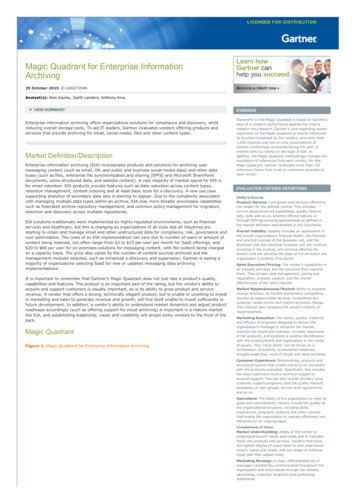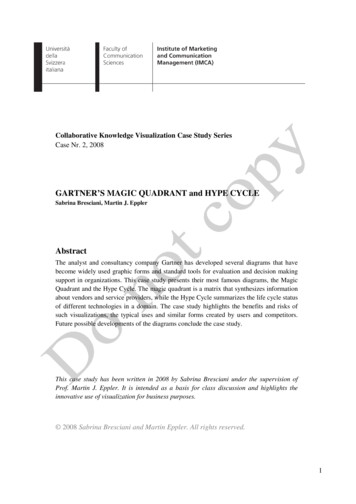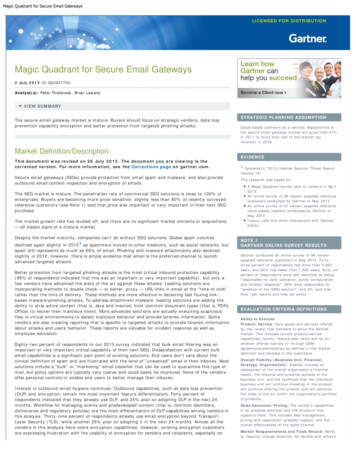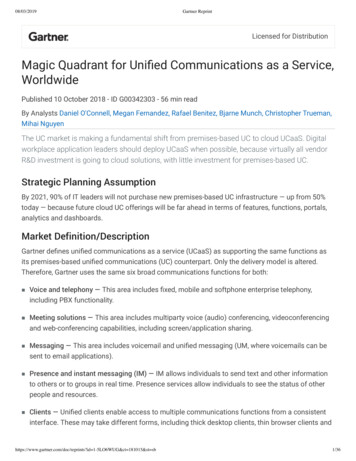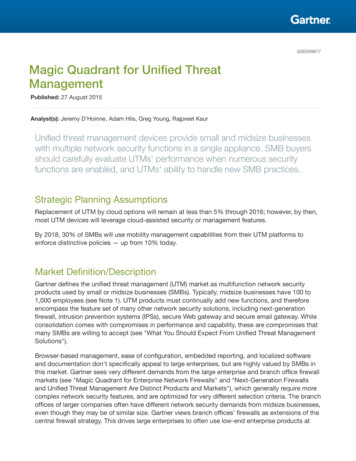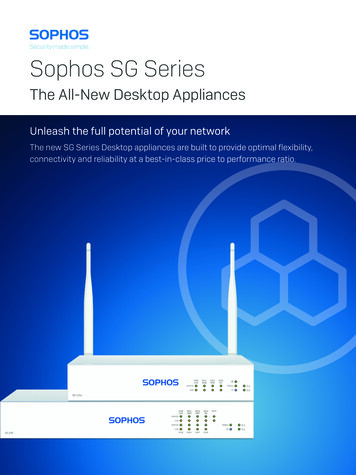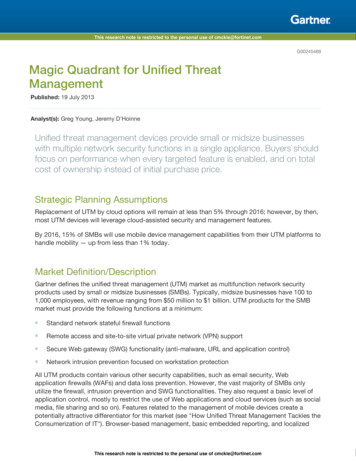
Transcription
This research note is restricted to the personal use of cmckie@fortinet.comG00245469Magic Quadrant for Unified ThreatManagementPublished: 19 July 2013Analyst(s): Greg Young, Jeremy D'HoinneUnified threat management devices provide small or midsize businesseswith multiple network security functions in a single appliance. Buyers shouldfocus on performance when every targeted feature is enabled, and on totalcost of ownership instead of initial purchase price.Strategic Planning AssumptionsReplacement of UTM by cloud options will remain at less than 5% through 2016; however, by then,most UTM devices will leverage cloud-assisted security and management features.By 2016, 15% of SMBs will use mobile device management capabilities from their UTM platforms tohandle mobility — up from less than 1% today.Market Definition/DescriptionGartner defines the unified threat management (UTM) market as multifunction network securityproducts used by small or midsize businesses (SMBs). Typically, midsize businesses have 100 to1,000 employees, with revenue ranging from 50 million to 1 billion. UTM products for the SMBmarket must provide the following functions at a minimum: Standard network stateful firewall functions Remote access and site-to-site virtual private network (VPN) support Secure Web gateway (SWG) functionality (anti-malware, URL and application control) Network intrusion prevention focused on workstation protectionAll UTM products contain various other security capabilities, such as email security, Webapplication firewalls (WAFs) and data loss prevention. However, the vast majority of SMBs onlyutilize the firewall, intrusion prevention and SWG functionalities. They also request a basic level ofapplication control, mostly to restrict the use of Web applications and cloud services (such as socialmedia, file sharing and so on). Features related to the management of mobile devices create apotentially attractive differentiator for this market (see "How Unified Threat Management Tackles theConsumerization of IT"). Browser-based management, basic embedded reporting, and localizedThis research note is restricted to the personal use of cmckie@fortinet.com
This research note is restricted to the personal use of cmckie@fortinet.comsoftware and documentation, which don't appeal to large enterprises, are highly valued by SMBs inthis market. SMBs should evaluate UTM devices based on the controls they will actually use, theperformance they will get for those features, and the quality of vendor and channel (and managedservices) support that is available.Given the continuing economic uncertainty, most SMBs have strong IT budgetary and staffingconstraints. This causes them to highly value ease of deployment and use, strong local channelsupport, and flexible pricing. Leading UTM vendors will: Be aggressive and flexible in pricing, reducing upfront costs, eliminating hidden fees, andensuring durable software and hardware support. Focus on midsize businesses' need for the right network security at the right price, rather thantrying to upsell them to enterprise products and capabilities. Provide product management features that simplify deployment and ongoing operations. Make it easy for customers with evolving security needs to add licenses to existing platforms byunifying their support contract renewal dates. Offer efficient vendor technical support and easy-to-diagnose systems to value-added resellers(VARs), which often handle a large number of devices with understaffed technical teams. Be early to add new security features that are showing up as separate point products.Many UTM vendors are heading toward the console and management being fully in the cloud.Gartner believes that, although it's convenient for the vendors to do so, a portion of the SMBmarket will not accept this exclusively cloud model for reasons of latency, trust, and being able toaccess the console when under attack. Reporting and log retention are well-suited to the cloud, butnot exclusively.For 2012, Gartner estimates that worldwide revenue in the UTM market totaled approximately 1.53billion, which represents an 18.7% growth over our estimate for 2011 (see Note 1). Gartner believesthat the UTM market will continue to grow faster than many other security markets, but we also seea number of trends applying downward pressure on market growth. Regardless, we forecastcontinued growth in the UTM market of approximately 15% compound annual growth rate through2018.We see the following positive trends continuing to drive growth in the UTM market: A steady number of new, small (that is, fewer than 100 employees) organizations. SMBs in emerging countries buying their first UTM products to secure increasingly faster andmore highly business-critical broadband Internet connections. This scenario represents"greenfield" growth for the market — often with a preference for country or region-specificvendors. A continued refresh of first-generation UTM products by SMBs — especially midsizebusinesses (100 to 999 employees), and especially in North America and Western Europe —due to product aging and the demand for higher-speed Internet connectivity. This demandPage 2 of 22Gartner, Inc. G00245469This research note is restricted to the personal use of cmckie@fortinet.com
This research note is restricted to the personal use of cmckie@fortinet.comdrives the replacement of existing product with the incumbent's newer version, or replacementof the incumbent by a competitor.Some trends will limit market growth: The increased use of smartphones, tablets and even 4G-equipped laptops moves more smallbusiness Internet traffic to direct connections to wireless data service providers, as opposed tothrough UTM appliances to wired Internet service providers (ISPs). The pricing and features of cloud-based SWG services (see "Magic Quadrant for Secure WebGateways") are very attractive to small businesses because they offer flexible pricing and meetthe needs for securing mobile users. While most of those services only deal with SecureSockets Layer (SSL) and HTTP traffic, they represent most of the needs of many smallbusinesses, and can reduce their UTM needs to a simple firewall/router. However, the SWGmarket is smaller than the UTM market and follows a slightly slower growth. The increased use of cloud-based email (such as Google Apps for Business or Microsoft Office365) reduces the demand for email security, since those services include integrated emailantivirus functionality. As lower-midsize companies grow to become upper-midsize and enterprise size, their securityneeds will get more complex, and they will outgrow their UTM appliances and deploy enterprisenetwork security platforms, such as next-generation firewalls and SWGs.Gartner believes that the downward trends now balance the positive trends and might put increasedpressure on the market in the future, thereby causing us to maintain our UTM market growthforecast from our previous outlook. These trends have also led to limited entries/exits of vendorsinto/from this market. In 2012, Cassidian CyberSecurity, a subsidiary of the EADS Group, acquiredNetasq. Arkoon Network Security, Barracuda Networks, Endian and eSoft did not meet theinclusion criteria.Page 3 of 22Gartner, Inc. G00245469This research note is restricted to the personal use of cmckie@fortinet.com
This research note is restricted to the personal use of cmckie@fortinet.comMagic QuadrantFigure 1. Magic Quadrant for Unified Threat ManagementSource: Gartner (July 2013)Vendor Strengths and CautionsCheck Point Software TechnologiesCheck Point Software Technologies is one of the largest pure-play security companies, and hasbeen expanding from the enterprise security market to the UTM market since 2004. Check Pointhas been very active in the UTM segment. In the past 18 months, it has targeted SMBs with newappliances (primarily the 600 and 1100 series), with part of a global product line update (referred toPage 4 of 22Gartner, Inc. G00245469This research note is restricted to the personal use of cmckie@fortinet.com
This research note is restricted to the personal use of cmckie@fortinet.comas the "2012 appliances") and with the release of a common operating system (OS) for everysecurity gateway (GAiA). Its SMB portfolio now includes 11 appliances and a cloud-based securityservice. Fundamental to Check Point firewall offerings is the set of software options referred to asSoftware Blades.Strengths Check Point's reporting and management console is highly rated by midsize companies. Knownprimarily as an enterprise security provider, Check Point has expanded into the SMB space formidsize companies that are seeking premium firewall products. Check Point's UTM solutions benefit from its enterprise-level security features, such asThreatCloud and Anti-Bot. The Software Blades approach allows for customization of features. Selective direct user involvement with its UserCheck technology improves security awarenessand reduces the risk of policy infringement. The consolidation of the appliance portfolio and the unification of the different Software Bladesunder the GAiA OS will ease maintenance and reduce the learning curve for SMB resellers andend users. Check Point has very strong capabilities for virtualized versions and securing virtualization.Cautions Price is often cited as the primary reason for not selecting Check Point solutions. Check Point has approximately 30 different Software Blades. Having so many options createsan overly complex pricing scheme for many SMBs and small resellers, compared with thecompetition. Blade packages, however, are available for the purpose of simplification.CiscoCisco uses its network infrastructure placements as an entree to bundle in adjunct securitysolutions for SMBs. Cisco now addresses SMBs with the ISA500 Series for small businesses (fourmodels), the ASA 5500-X Series for midsize companies (two models) and the cloud-managed MXseries (six appliances) based on the Meraki solutions (acquired in 2012). In addition to the dedicatedsecurity solutions, Cisco has a large portfolio of network solutions that can provide securityfeatures, such as the Integrated Services Router (ISR).Strengths Cisco support is rated well by Gartner customers; its entrenchment in the network infrastructuremakes it easy to find well-trained staff to support Cisco security implementations. The ISA500 Series and ASA 5500-X Series show feature improvements compared with theprevious generations of products; the removal of the requirement for hardware add-in modulesPage 5 of 22Gartner, Inc. G00245469This research note is restricted to the personal use of cmckie@fortinet.com
This research note is restricted to the personal use of cmckie@fortinet.comfor intrusion prevention or content inspection allows the new ASA product line to compete withother midsize UTM devices. The cloud-based MX series provides an easy way to centrally manage distributed organizationslooking for PCI compliance. The integration of Cisco AnyConnect with the ISA500 Series and the ASA 5500-X Series, inaddition to the existing Cisco client for mobile devices, makes Cisco a good choice for SMBswith many mobile users.Cautions Cisco's UTM devices have low visibility among Gartner SMB clients and do not generate manyinquiries, because clients view Cisco primarily as an enterprise security player. The vendors wesurveyed continue to identify Cisco as one of the most replaced brands. Cisco's 2012 UTM refresh showed that it could catch up with basic SMB needs, but it still hasto demonstrate its ability to drive the market.ClavisterClavister, which is headquartered in Sweden, targets primarily ISPs with its cloud services. Itaddresses SMBs through its branded security appliances, the Eagle Series and Wolf Series. Also,Clavister's technology is provided as an OEM solution.Strengths The security quality of Clavister's products is often mentioned by its customers. Also, its ISO9001:2008 certification and two-year standard return-and-repair warranty appeal to SMBs thatweight reliability highly. The Clavister X8 series of rugged appliances is a good fit for specific midsize vertical industries.Cautions The focus on core firewall needs, rather than completeness of features, translates into acompetitive gap for specific use cases. Gartner has not observed notable client interest outside of Europe, and Clavister has generateda very low level of inquiry from Gartner clients over the past 12 months. Clavister was never cited as a competitive threat by surveyed vendors.CyberoamBased in India, Cyberoam is a pure-play vendor for the UTM market, focusing solely on SMBs. Overthe past nine months, it released its NG Series with 12 new appliances and five virtual appliances.Cyberoam consistently communicates about the integration of user identity in every component ofthe UTM configuration, and about the availability of Web Application Firewall on the UTM.Page 6 of 22Gartner, Inc. G00245469This research note is restricted to the personal use of cmckie@fortinet.com
This research note is restricted to the personal use of cmckie@fortinet.comStrengths Cyberoam's product development approach of providing competitive pricing, coupled with theregular addition of new features, has proved to be a successful choice for the SMB market. Its well-organized management interface minimizes the burden implied by the presence ofnumerous features. Cloud-based centralized management, which is free for certified partners, can be a valuableasset for managed security service providers (MSSPs). Users report that they like the built-in reporting capabilities.Cautions Cyberoam's visibility remains low with Gartner clients, and it is not yet cited as a threat bysurveyed vendors and resellers. Cyberoam does not yet have a significant sales presence in North America. Gartner believes that Cyberoam's channel marketing is overly focused on perceived competitorshortcomings, rather than on promoting its own brand and benefits to customers.DellDell acquired SonicWALL in 2012 and kept SonicWALL as the name of its firewall product line. Dellsells two product lines to the SMB market: the SonicWALL TZ Series for the smallest businessesand the SonicWALL NSA Series for small and midsize companies. It also targets the enterprisemarket with its SonicWALL SuperMassive Series, competing with established enterprise players onthe price/performance ratio. Dell also provides SSL VPN and email security gateway.Strengths Gartner often sees Dell shortlisted based on the SonicWALL brand being well-established in theSMB market. Many customers report to Gartner that the TZ Series product line is a cost-effective solutionwith very good overall performance. Low total cost of ownership (TCO) is often cited as areason for choosing Dell SonicWALL products. The TZ Series' clean wireless features are available for smaller locations, and Gartner hasobserved that retailers are interested in these noteworthy features. Dell's overall focus on midsize organizations aligns well with a UTM offering, and Dell's broadlogistical capabilities assist with deployments involving multiple geographies.Page 7 of 22Gartner, Inc. G00245469This research note is restricted to the personal use of cmckie@fortinet.com
This research note is restricted to the personal use of cmckie@fortinet.comCautions Surveyed vendors claimed that Dell SonicWALL is a brand they often replace. Gartner hasobserved that SonicWALL's acquisition by Dell has caused disruption for prospects that don'thave an existing Dell relationship because of changes in the channel. Gartner views Dell's efforts to move toward the enterprise markets as alienating the SMBs. Thelatest SonicOS releases — which have an increased number of features targeting the higherend of midsize markets and enterprises, as well as a marketing focus on the SuperMassiveSeries — increase this perception.FortinetFortinet is a security vendor based in California. It offers 10 FortiGate UTM appliance models aimedat the small and midsize market. The security product portfolio, including tokens and host agents(FortiClient), is designed to appeal to VARs as the route to SMB sales. With two new models in 2012(FortiGate-60D and FortiGate-100D), Fortinet continues to rely on its custom application-specificintegrated circuit (ASIC) architecture to provide a high price/performance ratio. The fifth majorversion of Fortinet's OS brought a new set of features aimed at managing phones and tablets, tryingto further expand the scope of UTM and to pressure competitors with advanced features.Strengths Fortinet continues to have the highest visibility of UTM providers among Gartner clients, and itis the company most frequently mentioned by the vendors we surveyed as a significant SMBcompetitive threat. Because Fortinet designs and builds its own ASIC (FortiASIC), and uses little OEM software(compared with most UTM vendors), it provides a very aggressive price/performanceproposition, which is important to SMBs that typically have limited security budgets. Fortinet has a very large R&D team. Gartner views Fortinet as setting the cadence in the UTMmarket, driving its competitors to react. Fortinet has a strong channel presence and provides local support in numerous countries.Cautions The frequent hardware and software updates make it harder to maintain a consistent level ofexpertise across Fortinet's widely distributed channel, which sometimes causes support issues. Users often report a noticeably greater-than-documented impact on performance when usingWeb antivirus and URL filtering. Customers should take this into account and assess actualperformance when doing competitive evaluations and product sizing.Page 8 of 22Gartner, Inc. G00245469This research note is restricted to the personal use of cmckie@fortinet.com
This research note is restricted to the personal use of cmckie@fortinet.comgateprotectGateprotect is a German company, headquartered in Hamburg. It focuses on the SMB and MSSPmarkets, with nine models targeting companies composed of 10 to 10,000 users. Gateprotectemphasizes its management interface, and uses its proprietary solution (eGUI) to configure theUTM. It develops the core of its software (v.9), but relies on OEM partners that are specialized intheir field for some security inspections. In 2012, gateprotect secured a new round of investmentthat was intended to accelerate its international expansion. It provides virtual images of itsappliances and a centralized management tool for MSSPs.Strengths Gateprotect visual configuration emphasizes the ease of creation of security policies, focusingon saving time for end-user and technical support services. Gateprotect maintains what Gartner views as a very competitive software release cycle toanswer the needs of SMBs.Cautions Gateprotect has low visibility and rarely appears on Gartner client shortlists (although there is aslight increase in Latin America). Increased efforts to expand beyond EMEA are still developing within the markets Gartnerobserves.HuaweiHuawei is a China-based company with a primary focus on network infrastructure solutions. ItsUnified Security Gateway (USG) product line includes seven models targeting SMBs. Huaweioperates in 40 countries, and its revenue comes mainly from China, Africa and the Middle East. Thecompany recently invested significantly in developing its channel to better address SMBs.Strengths Existing customers of Huawei's network solutions will get a good price for value and a shorterlearning curve with its UTM devices. The USG product line includes a comprehensive set of network options (such as 3G, xDSL andWi-Fi). Huawei is leveraging its hardware and software to deliver a very attractive price/performanceproposition. Because the vendor has a very large security portfolio, other offerings (such as itssecure wireless and tablet containers) can provide end-to-end security options for SMBs.Page 9 of 22Gartner, Inc. G00245469This research note is restricted to the personal use of cmckie@fortinet.com
This research note is restricted to the personal use of cmckie@fortinet.comCautions Like most infrastructure vendors, Huawei's main focus remains network and larger enterprisesor carriers. To address the SMB market, it has yet to shift its road map priorities toward coreSMB market needs. Huawei has low visibility outside the Asia/Pacific region for its security products. Its investment in the UTM market is still recent, resulting in software that is lagging behind othersolutions. However, Gartner views the Huawei UTM road map as very positive.Juniper NetworksJuniper Networks is a network infrastructure vendor based in California. It has a broad portfolio thatcovers network and security solutions. Its UTM offering (SRX Series) includes seven models andrelies on the Junos OS, which is the common platform for network and security appliances ofJuniper's portfolio. The vendor has enhanced its Web filtering with reputation-based scoring, andmade application control and visibility (AppSecure) available to the SRX Series.Strengths The use of a common OS for security and network components reduces training costs andcomplexity for UTM buyers that have other Juniper products in place. Users often cite good performance as the top reason to select Juniper.Cautions As an enterprise vendor, Juniper's road map and product strategy are not focused on the SMBmarket. Compared with its enterprise/carrier channel, Juniper has a limited dedicated channel focusedon the UTM market.KerioKerio is a U.S. company based in California. It has been selling UTM devices since 2004. The KerioControl Box appliance is offered in two models: as a software appliance (ISO file) or as a virtualappliance. Kerio has added URL filtering, IPv6 and IPsec VPN support.Strengths Users report to Gartner ease of use and product quality as the main reasons for choosing Kerio. Vendor support is also highly rated.Page 10 of 22Gartner, Inc. G00245469This research note is restricted to the personal use of cmckie@fortinet.com
This research note is restricted to the personal use of cmckie@fortinet.comCautions Kerio generates a very low level of inquiry from Gartner clients, and it does not have anextensive specialized channel to address the UTM market. Kerio's default license is limited to five users. The competition frequently offers unlimited usersout of the box. Kerio provides a limited set of features and appliance choices, compared with its competitors.NetasqNetasq, founded in 1998, is a French UTM vendor that was acquired by Cassidian CyberSecurity, asubsidiary of the EADS Group. The U Series, its product offering for SMBs, includes six appliancesalong with virtual appliances. Netasq developed its own intrusion prevention system (IPS) andapplication detection engine. In 2012, Netasq completely renewed the UTM product lines (the Smodels) with increased performance and IPsec hardware acceleration. It also changed its serviceoffer — extending it for up to five years.Strengths Netasq has a simple service offering with a low-cost bundle that's often cited as good for TCO. Integration of application versioning and vulnerability detection are often cited as criteria forchoosing Netasq. Users consistently say that support from Netasq and channel partners is very good.Cautions The majority of Netasq's customers are in EMEA, and the company has low visibility amongGartner customers. Gartner believes that the acquisition by Cassidian will lead to a shift in Netasq's focus fromSMBs to larger enterprises and governments, potentially taking the development and capabilityfocus away from SMB customers.SophosSophos is headquartered in Boston and in Oxford, U.K. It was initially providing endpoint securitysolutions, and in 2011, it integrated a UTM offer with the acquisition of the German-based companyAstaro. The acquisition went smoothly and did not slow the pace of new releases. Sophos nowoffers eight UTM appliances to protect companies with 10 to 5,000 users. Version 9.1, the latestrelease of its OS, adds management features for Sophos endpoints. The vendor continues to offerfree UTM software (software appliance or virtual appliance) for home usage, and it benefits from anactive community that provides quick feedback on emerging needs.Page 11 of 22Gartner, Inc. G00245469This research note is restricted to the personal use of cmckie@fortinet.com
This research note is restricted to the personal use of cmckie@fortinet.comStrengths Sophos' ease of use consistently rates high among customers that Gartner has interviewed.Monitoring and configuration are well-integrated. The interface contains general guidance on what each feature does. This recognizes the SMBreality that not all operators are firewall experts. Sophos Remote Ethernet Device (Red) appliances are a competitive advantage when it comesto secure small branch offices. New Wi-Fi features added in Version 9 make it easy to manage temporary guests with vouchersand time or quota limits.Cautions Customers report to Gartner that quality of service, VPN features and visibility into user activityneed improvement. Sophos' UTM device is present less often on Gartner clients' shortlists than other Leaders' UTMdevices. Sophos' application control features need to be expanded beyond the Web and betterintegrated with users in the firewall policy.WatchGuardWatchGuard, a U.S. company with headquarters based in Seattle, was one of the first to ship UTMplatforms to the market. Its portfolio for SMBs is composed of 11 models (XTM 2, 3, 5 and 8 Series).WatchGuard's comprehensive offer also includes Web- and email-dedicated gateways.WatchGuard is a well-established UTM vendor with a strong focus on the SMB market. It haslaunched virtual appliances, and has extended its offer to MSSPs with a new program and aspecific cloud-based solution for initial deployment (RapidDeploy).Strengths Customers often cite the low initial price as a reason to select WatchGuard. WatchGuard has a strong and loyal channel presence in many countries. Recent hardware and software upgrades have brought significant performance improvements. An increased focus on MSSP needs reflects positively on the overall user experience.Cautions WatchGuard offers a large number of products and services that are often very similar. Channelpartners and buyers tell Gartner this is confusing. WatchGuard scored low as a significant UTM competitive threat by the vendors we surveyed.Page 12 of 22Gartner, Inc. G00245469This research note is restricted to the personal use of cmckie@fortinet.com
This research note is restricted to the personal use of cmckie@fortinet.comVendors Added or DroppedWe review and adjust our inclusion criteria for Magic Quadrants and MarketScopes as marketschange. As a result of these adjustments, the mix of vendors in any Magic Quadrant orMarketScope may change over time. A vendor appearing in a Magic Quadrant or MarketScope oneyear and not the next does not necessarily indicate that we have changed our opinion of thatvendor. This may be a reflection of a change in the market and, therefore, changed evaluationcriteria, or a change of focus by a vendor.Added Huawei was added. Dell acquired SonicWALL, which was in the previous Magic Quadrant, and the brand name haschanged to Dell.Dropped Trustwave was not included because it sells UTM primarily as an element of a bundledmanaged service offering rather than as appliances. Netgear was dropped because it focuses on a subset of the SMB market.Inclusion and Exclusion CriteriaInclusion CriteriaThe following minimum requirements were used to determine which UTM companies met thecriteria to be included in this Magic Quadrant under the following conditions: They shipped UTM software and/or hardware products — targeted to midsize businesses —that included capabilities in the following feature areas at a minimum: Network security (stateful firewall and intrusion prevention) Web security gateway Remote access for mobile employees (VPNs) Email security They regularly appeared on Gartner midsize client shortlists for final selection. They achieved UTM product sales (not including maintenance or other service fees) of morethan 7 million in 2012, and within a customer segment that's visible to Gartner. They alsoachieved this revenue on the basis of product sales, exclusive of managed security service(MSS) revenue.Page 13 of 22Gartner, Inc. G00245469This research note is restricted to the personal use of cmckie@fortinet.com
This research note is restricted to the personal use of cmckie@fortinet.comExclusion Criteria There was insufficient information for assessment, and the companies didn't otherwise meet theinclusion criteria, or aren't yet actively shipping products for revenue. Products aren't usually deployed as the primary Internet-facing firewall (for example, proxyservers and network IPS solutions). Products are built around personal firewalls, host-based firewalls, host-based IPSs and WAFs— all of which are distinct from this market. Solutions are delivered primarily as an integral part of MSSs, to the extent that product salesdidn't reach the 7 million threshold.Evaluation CriteriaAbility to ExecuteProduct/Service: Key features — such as ease of deployment and operation, console quality,price/performance, range of models, secondary product capabilities (for example, logging,integrated Wi-Fi support and remote access), and the ability to support multifunction deployments— are weighted heavily.Overall Viability: This includes a vendor's overall financial health, prospects for continuingoperations, company history, and demonstrated commitment to the multifunction firewall andnetwork security market. Growth of the customer base and revenue derived from sales are alsoconsidered. All vendors are required to disclose comparable market data, such as UTM revenue,competitive wins ver
Magic Quadrant Figure 1. Magic Quadrant for Unified Threat Management Source: Gartner (July 2013) Vendor Strengths and Cautions Check Point Software Technologies Check Point Software Technologies is one of the largest pure-play security companies, and has been expanding from the enterprise security market to the UTM market since 2004. Check Point
